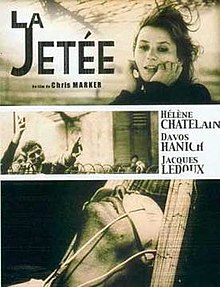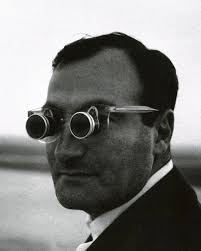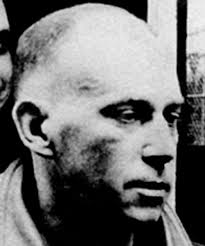IMDb metadata is 28 minutes of run time @ 8.2 from 23,848 raters.

A Sy Fy short that often appears on lists of great movies, and I can see why. It is arresting and mysterious.
It is after an atomic World War III and some think they have won but most have died. Survivors have dug into the Earth.
Paris is a burned cinder but deep down in the Châtelet metro station in the first arrondisement where six lines pass are the survivors. A lot of them. They have prisoners on whom they perform experiments.
One prisoner is selected and he prepares himself to meet a terrible fate with a mad and cruel scientist only to find a placid doctor who explains that they are trying to time travel either to the past to avert the catastrophe or to the future to get help. Some who have tried to travel through time have been driven nuts, others just died, not being strong enough for the emotional wrench and the mental effort.
The major prop is an eye mask with some wires inserted in it and a hypodermic. The rest is imagination!
The Man without a name submits and dreams or travels. No one is sure which it is. He, too, is unsure. The doctor is unsure. The viewer is unsure. the fraternity brothers dozed.
In the course of his backward travels he meets a woman to whom he tells his story and she listens, calm, attentive, interested. He keeps going back to her, though we learn nothing about her.
He also makes one forward trip and meets in a cloud of mist four individuals from the future with two franc coins stuck to their foreheads. They reject him but later relent and offer him personal sanctuary but they cannot help the others.
However by then he prefers the past with She who does not have a name.
In a dreamy sequence he goes to her at Orly aeroport on the observation deck, the pier, la jetėe of the title, and he is murdered by someone from the Châtelet metro station who is there with the other prop, the scary goggles optometrist use to calibrate lenses corrections.

He realises, as he dies, that he has seen this death, his own death, before. Huh. All very post-modern.
He dies. No one can escape fate is the moral, it seems.
There is an intermittent voiceover narrative that is laconic and cryptic. And all the film is still photographs, many striking ones of Paris in the spring and the gothic underground refuge evoking German expressionism. But all is done with a light hand.
At times in the silence, and there is a lot of that, there is a nearly inaudible whispering in German. Don’t know what to make of that. An echo from the past.
Mostly the palette is dark in that underground redoubt with many shadows in the black and white photography.
It has been reissued by Criterion and a poor quality print can be found on You Tube.
I have seen at least one repetition of that scene on la jetėe at Orly in a krimi with Alain Delon or Lino Ventura. Can’t pin it down. Orly was shiny, new, modern, and futuristic in 1962. Later it became shopworn and dilapitated, as when I made a pilgrim to it in 1980.
Marker was a photographer among other things and borrowed a video camera for one very short scene of a few minutes. Like others at the time nuclear war seemed inevitable to him.
He did other conventional documentary films, and what he called photoessays.
While he was a traveller to make the documentaries and friends with cinemaistas like Alain Renais, he shunned all publicity. No interviews.
 Chris Marker
Chris Marker
Few photographs of himself. No official explanations of his work. Lived to 92. HIs last credit was in 2008.
